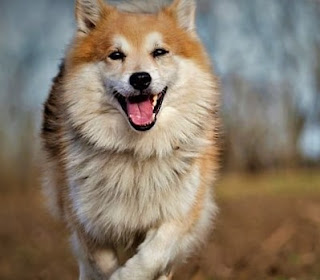Icelandic Shepherd Dog
History
In the ancient graves of Sweden and Denmark, in addition to
human remains, the remains of dogs were also found. The Icelandic Shepherd Dog
is very similar in body structure, size, and other features to the dogs whose
remains we have just mentioned. Everything would be fine, but these remains are
at least 8,000 years old.
Consequently, people in ancient times knew the ancestors of
modern Icelandic shepherds - these animals have a very ancient and rich
history. However, quite fair questions arise – if the ancestors of these dogs
lived in Sweden and Denmark, then, firstly, how did they appear in Iceland, and
secondly, why are they called Icelandic Shepherds?
When the Vikings discovered Iceland in the ninth century,
they brought their dogs with them. Over time, the population of dogs on the
island became quite large, while on the territory of their historical homeland
they became smaller. Including, and the appearance of many other breeds,
which was especially manifested in the Middle Ages. But Iceland, on the
contrary, for a long time was much more isolated, in contrast to European
countries, due to which the breed could be preserved as well as possible.
Even now, it is believed that the Icelandic Shepherd Dog is
very similar to its ancestors who came to the island in the 9th century. Dog
distemper at the end of the 19th century reduced the number of the breed by
three quarters, putting it on the verge of extinction, which is why the Icelandic
authorities in 1901 imposed a ban on the import of dogs to prevent possible
external sources of infection. The Association of Icelandic Dog Breeders was
established in 1969.
Characteristics of the breed
popularity 01/10
training 10/10
size 05/10
mind 10/10
protection 10/10
Relationships with
children 08/10
Dexterity 07/10
Molting 08/10
Breed Information
|
Country |
Iceland |
|
Lifetime |
14-15 years |
|
Height |
Males: 31-46 |
|
Weight |
Males: 10-16 |
|
Length of coat |
average |
|
Color |
black-white, cream-white, gray-white, reddish-white |
Price |
300 - 600 $ |
Description
These are medium-sized dogs, with a strong, muscular physique.
The limbs are slightly shorter than average, the muzzle is slightly elongated,
the ears are erect. The tail is twisted into a ring and lies on its back. The
coat is long, the color is mainly red, but it can be black and white, creamy
white, gray-white, reddish-white.
Personality / Temperament
The Icelandic Shepherd Dog is a very friendly and open
breed. These dogs love contact with humans, and generally love people as such.
They have the concept of territorial ownership, their territorial instincts
will motivate the dog to defend his plot if it is a private house with a
fenced territory or an apartment, but innate friendliness will not allow the
Icelandic Shepherd dog to become a real ruthless watchman.
The breed has a high level of energy, which is
understandable, given the genetics and past of these dogs, and therefore needs
long walks and physical exertion. This will help to avoid destructive behavior
at home or depressive states, however, the dog will also need games and
activities at home. Spending an hour a day outside is not enough.
The Icelandic Shepherd Dog gets along well with other pets,
only if they are not rodents. Problems are likely to arise here since first of
all, such small animals as a dog are prey. You can make friends with cats, but
it is better to do it at an early age. The Icelandic Shepherd Dog treats
children well, spends time with them with joy, plays, and sometimes feels like a
nanny.
However, keep in mind that the dog has its limit of
patience, in addition, it is a fairly large dog - you should not leave him
alone with children under five years old. This breed perceives strangers
without aggression, often even friendly, although when the dog is in his
territory and realizes this, he may have protective instincts. Accordingly, the
dog barks, and barks a lot, this is an innate quality, but you can train the
pet to shut up on command. The Icelandic Shepherd dog loves his family
indefinitely, there are usually no problems in training.
Common diseases
The Icelandic Shepherd Dog is a very healthy and strong
breed that rarely gets sick.




.jpg)
0 Comments